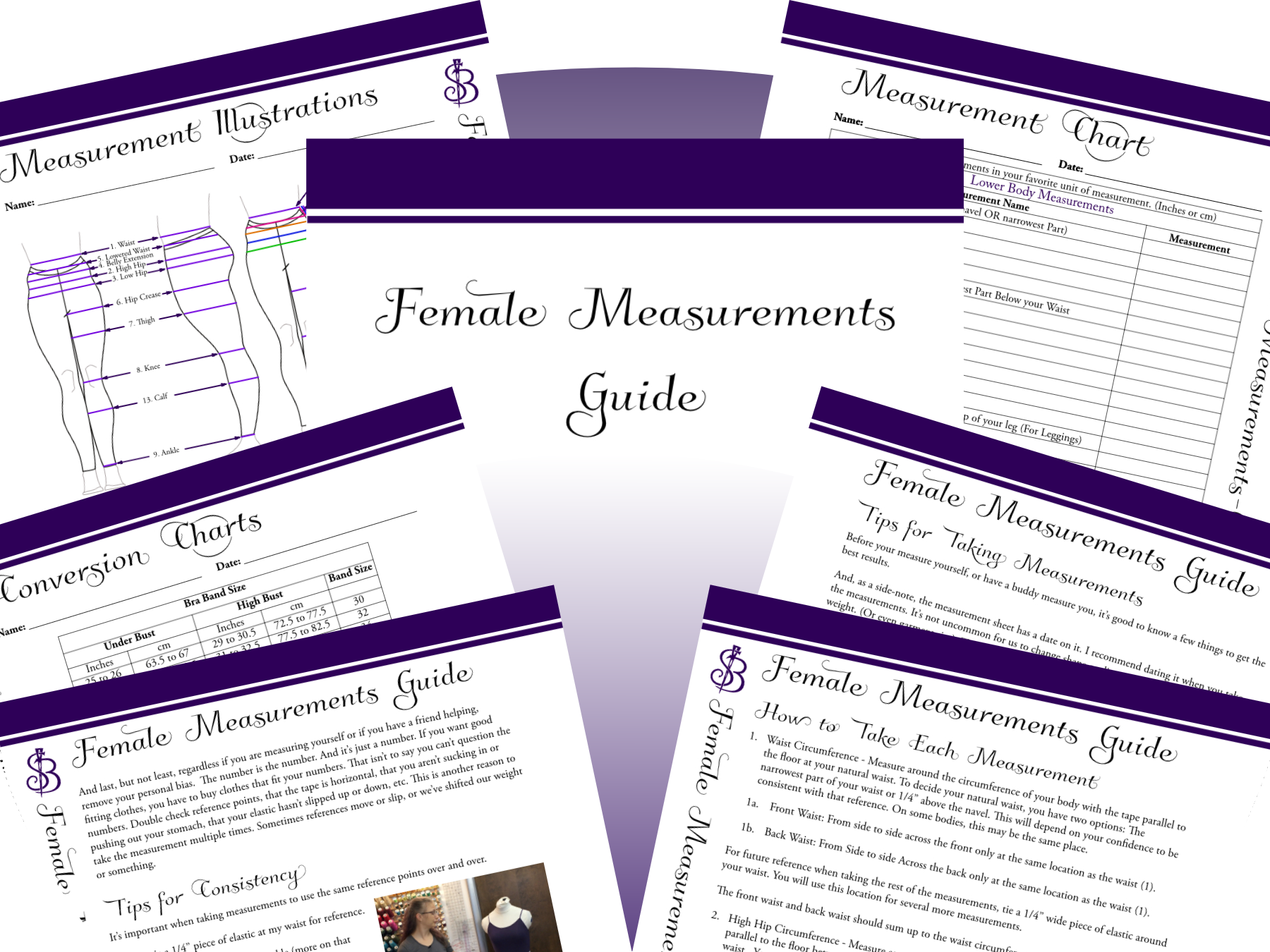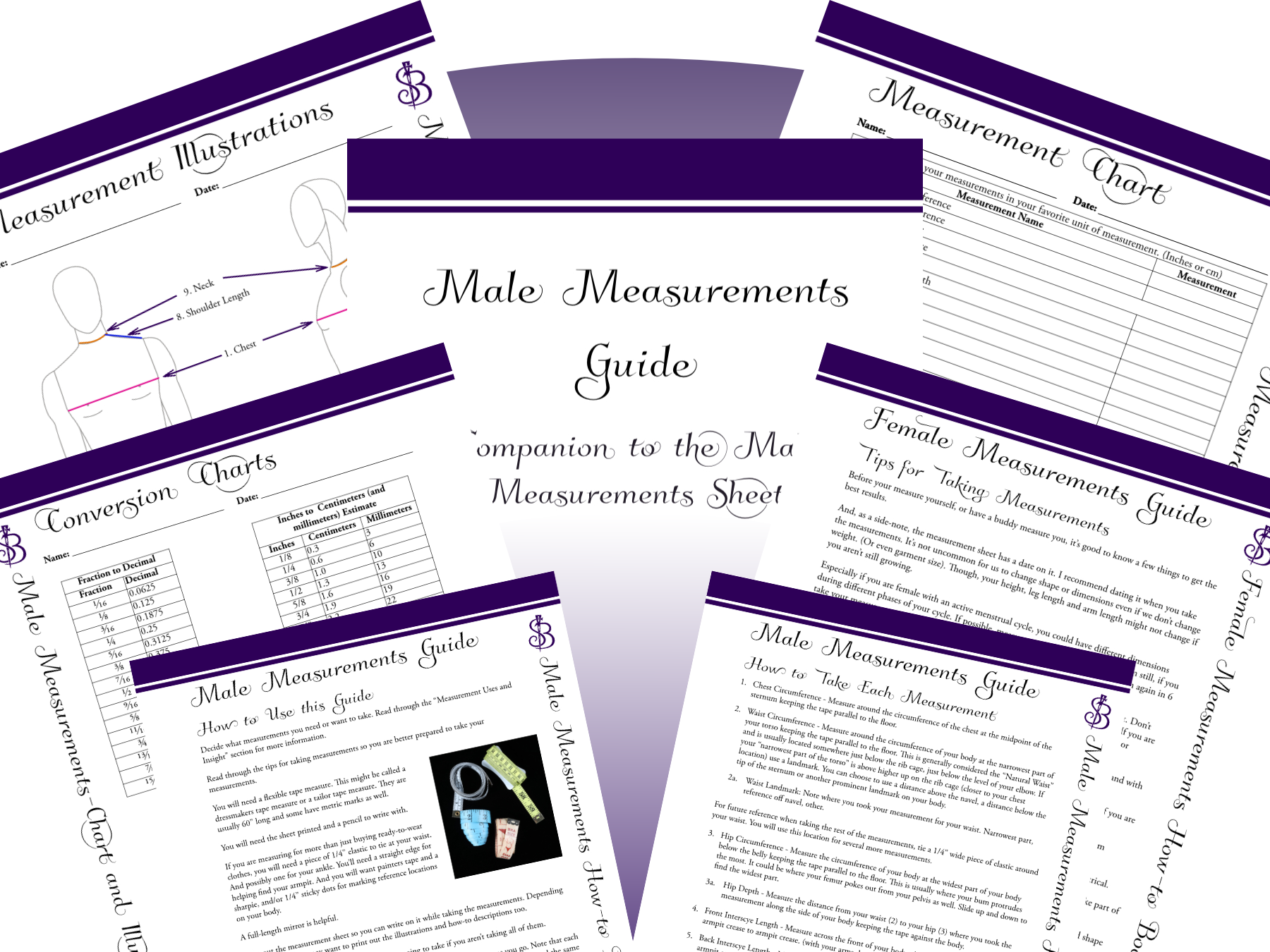Easily keep track of body measurements for sewing and buying clothes
Stop wasting time taking measurements every time you need them.


Whether you buy clothes online or sew your own, you need accurate measurements to get a good fit.
It takes time and effort to get a good set of accurate measurements. And while buying clothes sized S, M, or L, you can maybe get away with “ballpark” accuracy, when buying actual sized stuff it’s more important to use solid reliable measurements to get the best fit.
Buying clothes online can be challenging. You have to find the size chart and interpret the measurements listed there. Only sometimes do they actually tell you how to take the measurement for that specific chart.
You need accurate measurements for sewing your own clothes from a commercial pattern or self-drafted pattern.
Pattern envelopes assume you know how to accurately take your hip, waist and bust or chest measurements.
Not all measurements are used for all purposes. What is really meant by “arm length” or “waist circumference”? Get all that information and more in this handy guide.
What you get in each downloadable set.
Printable Measurement Sheet
Document your measurements
Super handy if you draft your own patterns for yourself and especially if you draft for others. You can keep multiple copies with your patterns.
And since we often change size, and especially shape over time periodically re-take the measurements so you can use your most up-to-date set when needed.
Detailed Instructions & Illustrations
Get detailed instruction on how to take eash measurment (with illustrations).
Ever wonder how to take your waist or hip measurement? This guide answers all. And some measurements may be different between men and women, even though they are the same name (hello inseam).
The companion guide can be printed, but is meant more for reference so you can save paper and only print what you need.
Common Measurement Uses & Insights
Anthropomorphic (body) measurements are used for everything from buying clothes online to drafting patterns. It’s good to know what measurements are commonly used for each of these applications.
There are measurements used for selecting clothing sizes online that are not used for pattern drafting. And of course, even more so the other way around.
The companion guide covers what measurement to use for what application.
In each downloadable set you get:
- A printable measurement sheet (with a 3-ring binder margin) that’s 2 pages or 1 page if printed double sided
- A printable measurement sheet (with a 3-ring binger margin) that includes the illustrations for each measurement for reference if needed.
- A Companion Guide with details on how to take each measurement, what they are commonly used for, tips for getting consistent accurate measurements and tips for measuring yourself solo.
The female guide has a discussion on bra sizing as well.
Female
Measurement Chart and Guide- Printable Measurement Sheet
- Printable Illustrations for Reference
- Companion Guide
- Bra Sizing
Bundle
Female and Male Guides- Female Measurement Chart
- Female Companion Guide
- Bra Sizing
- Male Measurement Chart
- Male Companion Guide
- Printable Illustrations
Male
Measurement Chart and Guide- Printable Measurement Sheet
- Printable Illustrations for Reference
- Companion Guide
- Bra Sizing
Bundle
Female and Male Guides- Female Measurement Chart
- Female Companion Guide
- Bra Sizing
- Male Measurement Chart
- Male Companion Guide
- Printable Illustrations
Female
Measurement Chart and Guide- Printable Measurement Sheet
- Printable Illustrations for Reference
- Companion Guide
- Bra Sizing
Male
Measurement Chart and Guide- Printable Measurement Sheet
- Printable Illustrations for Reference
- Companion Guide
- Bra Sizing
Bundle
Female and Male Guides- Female Measurement Chart
- Female Companion Guide
- Bra Sizing
- Male Measurement Chart
- Male Companion Guide
- Printable Illustrations
Female
Measurement Chart and Guide- Printable Measurement Sheet
- Printable Illustrations for Reference
- Companion Guide
- Bra Sizing
Male
Measurement Chart and Guide- Printable Measurement Sheet
- Printable Illustrations for Reference
- Companion Guide
- Bra Sizing
Wondering Which to Buy (Male or Female)?
Guide to Choose Male or Female (or Both)
How to Use this Guide
This is a short explanation of the differences between the female and male measurement sheets.
Please use this guide and the measurement sheets as guides to create or buy clothes. It is in no way a declaration that you need to pick between male and female identities.
Personally, I have need for both in my sewing. And since I buy clothes online, and so does my significant other, I’ve found that documenting measurements is just easier than constantly having to re-measure to pick sizes online.
Differences between the measurement sheets
Male and female pattern drafting are different. And since all clothes are created are created from a pattern, this difference does matter even when buying clothes from ready-to-wear.
The female measurement sheet has 10 more measurements than the male measurement sheet. (50 vs 40)
The actual difference between the two sheets, though, is more than that. Some of the same named measurements are taken differently. For example, the outseam measurement, is taken differently between the two forms, and the female sheet allows for measuring multiple locations which could be helpful in skirts.
Most notable, is that the female sheet contains measurements and information to accommodate breasts. So there are multiple measurements for the upper body on the female sheet that just aren’t used in men’s pattern drafting. And generally men don’t need to calculate a cup size.
On the male sheet, it’s assumed that there is a natural waist, a navel circumference and a pant-waist location. Meaning that most men have a natural waist above their navel and either choose to wear their pants at their navel or below their navel. Whereas, the assumption on the female sheet is that the natural waist is where skirts and pants sit, unless a lowered or empire waist are drafted, and those measurements are accommodated.
Another notable measurement on the male sheet that is not on the female sheet is the full arm length. I’ve seen this used online for sizing of shirts and jackets, but I have not seen it used in pattern drafting. And I would hope it’s not used in pattern drafting because it simply doesn’t give enough information to draft a decent fitting shirt or jacket. And if you’re drafting your own patterns, likely you want a really good fit.
Reasons to choose one over the other
Without getting into the details of what I know about pattern drafting, which admittedly isn’t a whole lot since I’m not a professional pattern drafter, why would you pick one form over another.
If you really only want one or can only afford one, my first inclination is to use the one you’ll be most likely to sew from or buy from. For example, if you are male and you will only ever buy or sew male clothes get the male one. Likewise if you’re female.
However, if you really aren’t sure, you can just get the female one and do some research to adapt the “how-to” measurements for the male form for male drafting. Then cross out the non-needed measurements and pencil in those weird measurements used for buying clothes online.
If you need to accommodate breasts, get the female sheet, even if you want to minimize them. The measurements should work themselves out to give you a well-fitting garment even if you are wearing a minimizer. On the flip side, it could be fun to take all the measurements on both sheets and draft patterns for the same person using two different methods to see what works better.
Male and female pattern drafting follows different methods from each other, likely because they have different origins. Men would go to the tailor, which wash likely a man for propriety reasons, to get clothing. Women would see a dressmaker, likely a female again for propriety reasons, to get their dresses. (Obviously this is for those that were wealthy enough to be able to afford this kind of clothing and not just sewing cotton muslin together to make their own at home.) But this means that the two methodologies developed completely separate.
Add to that, the typical male form varies from the female form in a few notable ways. The first is that typically, a female will have a larger bust measurement than under bust measurement this is why we have to wear bras. Men don’t and they only need one measurement, the chest measurement. The other notable difference is that men’s waist to hip ratio is usually closer to 1. And women typically have a much smaller waist to hip ratio. And drafting methodologies and the measurements that support them accommodate this difference by providing more measurements for the female through the hips.
Do all humans fall into these “typical” measurement ratios? Of course not. This is why for some figures, it’s really hard to find clothes that fit. Because even when a person is close to a “standard” there’s still a lot of variation that needs to be accommodated.
Some of these differences are simply because bone structure, namely the pelvis, is different between males and females. But it is also affected by hormones which will determine how much muscle mass a person has, and where they carry their weight. Age, repeated weight loss and weight gain cycles, posture, illness, genetics, and many other factors will also affect weight distribution and therefore body shape.
I’m offering the bundle at nearly 25% discount from buying each separately. So if you can, just get both and you’ll have them.